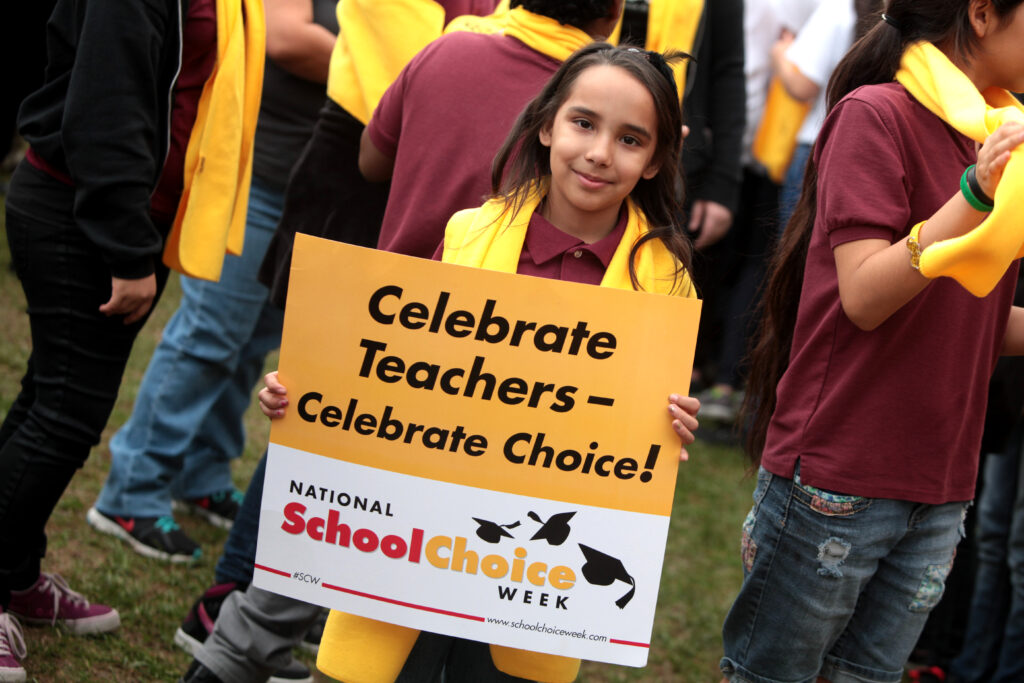Since 2011, National School Choice Week has been celebrated in late January to raise public awareness for education choice and to “help families discover the traditional public, public charter, public magnet, private, online, and home education options available for their children.” So far, National School Choice Week has been extremely successful in advocating for more education choice, however, there remains much more work to be done.
Presently, approximately nine out of 10 K-12 students in the United States attend government-run public schools. This is not because most parents prefer that their children attend public schools. Rather, it is because the vast majority of American families cannot afford to subsidize public schools through their state and local taxes while simultaneously paying out-of-pocket for their children to attend non-government schools.
In fact, most parents strongly prefer that their children attend a school other than the one and only public option arbitrarily assigned to them based on their geographic location.
This is especially true for parents with children trapped in under-performing and dangerous public schools. In recent years, standardized test scores show public schools have done an absolutely awful job in properly educating their students for a successful future.
My home state of Illinois is a prime example of the decaying state of public education. In 2023, only 35 percent of Illinois public school students in grades three to eight met or exceeded proficiency levels for English language arts (ELA) and only 27 percent met or exceeded proficiency levels for math.
At the high school level, Illinois public school test scores are similarly dreadful. Only 31 percent of Illinois high schoolers met or exceeded the proficiency standard for ELA and 26 percent scored proficient in math.
On the National Assessment of Education Progress (NAEP), “the largest nationally representative and continuing assessment of what America’s students know and can do in various subject areas,” 31 percent of Illinois fourth graders scored proficient in ELA and an abysmal 21 percent tested proficient in math.
As academic achievement and test scores continue to head in the wrong direction in Illinois public schools, so, too, is “chronic absenteeism” and “chronic truancy.” In 2023, 28 percent of Illinois students missed at least 10 percent of school days with or without a valid excuse and 20 percent were “chronically truant.”
Student discipline has also emerged as a major problem. In 2023, the state recorded 250,351 “Discipline Action Incidents” committed by 114,218 students. This includes 15, 219 incidents involving violence with physical injury and 2,644 dangerous weapon incidents.
Despite these appalling statistics, which are the norm in far too many states, Illinois lawmakers terminated the state’s sole school choice option at the end of 2023: the highly popular and highly successful Invest in Kids Act.
While blue states like Illinois continue to wage all-out war on school choice, a different trend is emerging in red states. In 2023, Arizona, Arkansas, Florida, Iowa, and Utah passed universal school choice laws. In 2024, this trend is expected to continue.
Two of the most alluring aspects of school choice are that it results in less overall education spending and better academic outcomes.
On average, K-12 public schools spent $14,347 per pupil in 2021, according to the U.S. Census Bureau. Several states, such as New York, Vermont, Connecticut, New Jersey, and others spent more than $20,000 per student. On the other hand, the nation’s 22,440 private K-12 schools average tuition rate is $12,350 per student.
In Illinois, the state spends on average $20,152 per pupil in public schools whereas the average tuition for a private school registered at $8,464.
Generally, private schools are more affordable than public schools because they lack the massive bureaucracies that have become ordinary among public school districts. Private schools are more efficient and devote more of their resources straight into the classroom, whereas public schools and their bloated district offices divert precious resources to frivolous programs that have little to do with improving educational outcomes but lots to do with appeasing teacher unions and creating permanent bureaucratic positions.
What’s more, students attending private schools consistently outperform their public school peers on nationwide, standardized tests including the NAEP, better known as the “Nation’s Report Card.”
For most Americans, school choice is a commonsense policy that places parents, not education bureaucrats, in charge of their children’s education. This is the crux of the matter.
Eventually, I believe the tide will turn in favor of more school choice. Parents should possess the fundamental right to choose the educational option that best fits the unique needs of their children. Who knows, maybe a decade from now, school choice will be universal, making National School Choice Week more or less redundant. That would certainly be worth celebrating; but, until that day comes to fruition: Happy National School Choice Week, America.
Photo by Gage Skidmore. Creative Commons Attribution-Share Alike 2.0 Generic.





